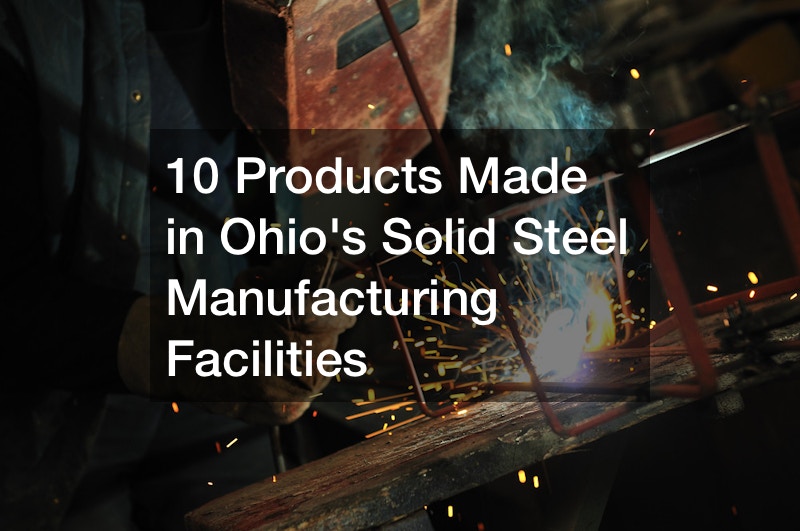Ohio’s steel industry has a rich history. Steel manufacturing began in Ohio in the late 19th century and continues to date. There are several steel products that Ohio’s solid steel manufacturing facilities produce. These include:
1. Recycled Steel Products
Steel is melted down and used to create new steel products, typically known as recycled steel products. This approach to manufacturing is ethical and sustainable and helps to reduce waste while helping to conserve natural resources. Steel recycling uses less energy than manufacturing new steel from scratch and is more eco-friendly as it reduces greenhouse gas emissions. Equipped with high-end equipment and technology, solid steel manufacturing facilities in Ohio produce high-quality recycled steel products that satisfy relevant industry standards and customer demands.
Examples of recycled steel products manufactured in Ohio include wire, tubes, pipes, and structural steel. Manufacturing, automotive, infrastructure, and construction industries use these products. Recycled steel products aren’t limited to environmental benefits. They’re also a cost-effective alternative to newly manufactured steel products. They’re also strong and durable, making them dependable for various applications.
2. Stamped Automotive Parts

The automotive market encompasses a range of products. In addition to the parts needed in the manufacturing of automobiles, there’s a growing demand for aftermarket custom parts. These parts and components allow consumers to customize their cars to meet their unique needs. Stamped automotive parts are among the products produced in Ohio’s solid steel manufacturing facilities. Metal stamping processes produce various essential automotive parts and offer an affordable alternative for manufacturing customized vehicle parts.
Some automotive parts produced through metal stamping include seat latches, fuel pressure regulators, fuel injectors, brakes, steering wheel components, rearview mirror mounting plates, horn buttons, and the brackets used to secure floor mats. Together with technological advancements, metal stamping processes are constantly evolving and improving. Other than increased end-to-end automation, stamping machinery has also seen advancements. A popular advancement is the employment of electromagnetic tools.
The electromagnetic forces help accurately position the sheet metal, allowing them to interact with it better. By reducing the margin between stamps, electromagnetically assisted tools produce more complex, intricate forms while reducing material waste. According to IBIS World, Michigan, Ohio, and Indiana have the highest concentrations of the nation’s Automotive Metal Stamping industry. In the upcoming years, metal stamping for automotive applications will continue to increase.
3. Metal Doors for Industrial Facilities
Metal doors are also among the products manufactured in Ohio’s solid steel manufacturing facilities. Industrial facilities are the main target market for these products. These facilities typically house expensive machinery and inventory, sometimes worth millions. For this reason, Industrial doors must be durable to prevent unauthorized access.
A metal door made of a material such as steel is harder to knock down using force and resistant to manipulation with burglary tools. It can stop criminals in their tracks and prevent them from breaking into a building. These doors are also often bulletproof and resistant to caustic chemicals.
Wooden doors are ideal for various applications but aren’t the best fit for industrial buildings. They have high maintenance needs, not considering the nature of the environment in most industrial facilities. On the other hand, metal doors, such as steel doors, practically need no maintenance.
As long as a door has proper finishing, it resists warping, cracking, and rusting. Steel also performs substantially better as an exterior door than wood. Moreover, steel doors offer better insulation than wooden doors. Improved insulation lowers HVAC utility costs for industrial facilities. Wooden doors don’t offer such energy efficiency.
While dents or scratches are common on steel doors, it requires immense force to cause significant structural damage. Most damage is modest and easy to repair or conceal. Doors made using other materials often need replacements when damage is severe.
4. Metal Fencing Products

Solid steel manufacturing facilities in Ohio also manufacture metal fencing products. Among all the fence materials, metal is one of the most resilient. Fences of hollow steel can last up to 20 years, while those of aluminum, solid metal, and iron can last a lifetime. Other than occasional repainting to prevent rust, metal fences typically don’t need maintenance as they don’t rot or stain, and insects can’t cause damage.
A metal fence can withstand heat, moisture, and bad weather while maintaining excellent form. Its rust-resistance capabilities benefit from applying a protective coating by galvanizing and sandblasting. Routine cleaning performed by a professional metal fence company also helps. Metal isn’t the most affordable but not the most costly type of fence material. There are several solutions available to fit every budget.
Maintaining the finish of a steel fence is important. The factory coating wears off after a while. When the metal starts to rust, the damage can be permanent. Using a container of rust-preventative spray paint is enough to restore the finish on a metal fence. As aluminum doesn’t rust, periodic touch-ups to the coating will restore the color.
5. Hose Clamps and Springs
Solid steel manufacturing facilities in Ohio also manufacture hose clamps and springs. Various industries use these steel products for unique applications. Their primary purpose is to secure hoses, pipes, and tubing in place, which is key to their functioning. Some of the applications of a stainless steel hose clamp and spring include:
Automotive: Hose clamps are typically used in automotive applications to secure hoses and pipes in place. Some of the car components that use these steel products include cooling, fuel, and air intake systems, among other systems. Suspension systems and engine valve springs are common applications of steel.
Plumbing: Hose clamps and springs are also key components in the plumbing industry. They secure pipes and tubing in residential, commercial, and industrial plumbing systems. They’re key to preventing leaks and maintaining the integrity of the system.
Medical: Spring and hose clamps also benefit medical applications. To secure tubing, medical devices, such as blood pressure monitors, dialysis machines, and ventilators, use hose clamps and springs. They’re also key components in catheters.
Industrial: These steel products can also key in various industrial applications, such as hydraulic systems, pneumatic systems, and manufacturing equipment. They’re also common in agricultural equipment, such as irrigation systems and harvesting machines.
Overall, hose clamps and springs are essential components in many industries and applications, ensuring that pipes, tubing, and hoses remain securely connected and functional. They are versatile components that are relied upon for their strength, durability, and reliability.
6. Steel Pipe Fittings

Carbon steel pipe fittings are also among the products Ohio’s solid steel manufacturing facilities produce. In pipe systems, a fitting unites sections of straight pipe or tube, modifies it to different sizes or shapes, and regulates (or monitors) fluid flow for other uses. They facilitate a secure connection between pipes, ensuring the efficient and safe transportation of liquids, gases, and other materials without experiencing leaks.
There are several applications for steel pipe fittings. These include plumbing, heating, ventilation, air conditioning, and industrial processes, making them key components in the construction of buildings, infrastructure, and machinery. Other common applications for steel pipe fittings include steam systems, water systems, gas pipelines, and chemical processing plants.
Steel pipe fittings offer several benefits that make them superior to other materials and types. One of the most notable benefits of these steel products is their strength and durability. Steel is a robust, long-lasting material that withstands high-pressure levels and temperatures. Steel pipe fittings also have impressive corrosion-resistant capabilities, making them a popular choice for applications in harsh environments with corrosive materials.
Steel pipe fittings can take various shapes and sizes to make different products. These include couplings, elbows, tees, reducers, and caps. Each type of fitting is assigned a specific function, such as redirecting fluid flow or altering the pipe size. Depending on the type, manufacturers can thread the fittings to make them easy to screw onto the pipe. They can also glue or weld them into position.
7. Stainless Steel Tools
Solid steel manufacturing facilities in Ohio also manufacture stainless steel tools. These tools are popular for several reasons. They are highly durable and can withstand wear and tear from regular use. They resist common damages such as chipping, breaking, and bending, making them ideal for heavy-duty applications. Due to the exceptional resistance to rust and other forms of corrosion of steel, these tools are perfect for use in wet or humid situations.
Stainless steel fabrication products are also ideal in chemical or industrial situations since they can withstand exposure to harsh chemicals and other contaminants. Stainless steel tools are easy to clean and don’t require much maintenance. You can use soap and water or other cleaning solutions to clean them, and they don’t need to be greased or oiled. Use stainless steel tools in construction, automotive, and other sectors where strength and durability are mandatory. Examples of tools commonly using stainless steel include screwdrivers, pliers, wrenches, knives, claw hammers, and sledgehammers.
8. Metal Beams for Construction Projects

Metal beams for construction projects are also among the products Ohio’s solid steel manufacturing facilities produce. Metal beams come in various forms and sizes to suit multiple purposes and are constructed from several materials, including carbon steel, stainless steel, and aluminum. Metal beams are fundamental in construction projects requiring load-bearing capacities, such as bridges, buildings, and other infrastructure.
They serve to withstand external forces like wind and earthquakes, offer stability and structural integrity, and sustain the weight of a building. The strength-to-weight ratio of metal beams, which enables them to carry enormous loads without adding undue weight to the structure, is one of the key advantages of these products. One of the most important building materials, steel, is now the main component of many industrial, commercial, and residential construction projects. It’s also one of the most plentiful resources available today.
Compared to other construction materials like concrete and wood, metal beams are cost-effective. They’re also easy to install and need minimal upkeep, making them a great resource for construction projects. A metal building contractor installs metal beams using specialized tools.
9. Cargo and Storage Containers
Cargo and storage containers are also among the products Ohio’s solid steel manufacturing facilities produce. Several key processes and considerations are involved in producing cargo and storage containers. Steel, aluminum, or a mix of the two are common materials in the manufacturing of cargo and storage containers. These materials are durable, can tolerate extreme weather conditions, and are corrosion-resistant.
Metal sheets are cut, bent, and joined by welding during the construction of cargo and storage containers to create the frame and walls of the container. After that, the manufacturer paints or coats the container to prevent corrosion and rust. Cargo and storage containers come in various sizes and dimensions to accommodate varying cargo or storage needs. Standard sizes include 20-foot, 40-foot, and 45-foot containers.
Modifications to a steel cargo container, such as installing doors, windows, ventilation, insulation, and electrical wiring, are sometimes necessary to meet particular requirements. They can also be stacked and interconnected to create larger structures, such as office buildings or residential homes. Cargo and storage containers are also easy to transport.
10. Metal Roofing Supplies

Solid steel manufacturing facilities in Ohio also manufacture metal roofing supplies. Metal roof contractors use these supplies for the benefits they offer. Metals such as zinc, copper, aluminum, and especially steel are common in metal roofing supplies.
These materials go through various manufacturing processes, including cutting, stamping, and rolling, to fabricate them into sheets or panels. The applications of metal roofing supplies range from industrial, commercial, and residential construction projects. They come in several colors and finishes to meet various design needs. Projects use them for roofs, walls, and facades. Compared to other roofing materials, metal roofing supplies provide several benefits, including durability, energy efficiency, longevity, and minimal maintenance needs.
To provide effective waterproofing and sealing, metal roofing supplies require specialist installation. Metal roofing supplies, such as asphalt shingles or clay tiles, can be more expensive than other roofing materials. However, they offer a better return on investment over time due to their durability and longevity, which can reduce the need for costly repairs or replacements in the future.
Steel manufacturing has a long history in Ohio. The adoption of steel will continue to rise as more people realize the benefits of steel. This read provides insight into the products Ohio’s solid steel manufacturing facilities make.




Leave a Reply